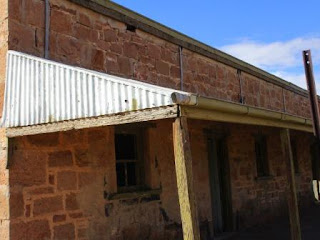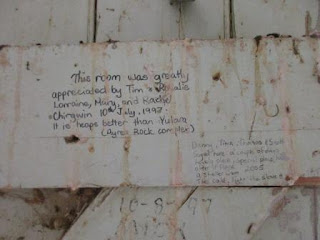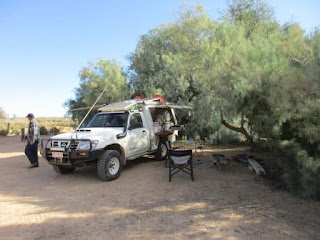7am
6.4 degrees – warm!! Compared with the last couple day it is. Still low black
clouds hanging around but you can see blue sky through them. No sun to warm us
but there is no wind which is good. Steve got the fire going from the coals
from last night – good timber here. Two cyclists rode by – they must be
freezing.
Packed
up and drove across the road and up the track to Strangways Overland Telegraph
Station ruins on a ridge. Like Peake it was used by pastoralist’s first – sheep
wool wash site. There are also Mound Springs here which is why the pastoralist
etc chose this place.
Strangways Springs
These were discovered by Major PE Warburton in 1858 and
the surrounding area was taken up for sheep grazing in 1862. The remains of the
woolshed, yards, homestead, water tank and cemetery are still evident and date
from the mid 1860s. In 1870 Strangways was chosen as a site for a repeater
station on the OTL as it had an assured water supply and accommodation for staff.
This complex remained in use until 1896 when the telegraph line was moved to
the railway line and the telegraph office to William Creek. North of
Strangways, the Oodnadatta Track follows a new alignment built on the Old Ghan
railway embankment. This construction took place in 1988 to overcome a
difficult creek crossing and a dune field.
Interesting
gate! Lucky we are able-bodied.
Lots
of information.
Three
walks here too. Picked up a brochure and headed off.
The
ground is covered in shale type rock.
A
dried up mound spring but the hollow must still hold water to keep the reeds
alive.
Came
to the cross roads for the walks – more information.
More
mound springs.
Walked
around the Settlement first. The Manager’s residence and Telegraph Station has
fallen apart. Good signage here too.
The
stone water tank beside it is holding up well.
The
Police Station (c1886) is just rubble.
Behind
that is the Woolshed (c1867) with dry stone walls to keep the sheep enclosed.
An original telegraph pole,
native pine (Callitris) brought to this treeless area by dray from the Flinders
Ranges. The pine is termite resistant and has a strong, straight trunk.
The
ground is covered in broken bottles.
The
kitchen and living quarters (c1867) – built for the pastoralist then extended
during the Telegraph Station era.
Nearby
is the Ration Store also from the pastoralist era.
The
Men’s Quarters & Store was also built by pastoralist then extended during
the OTL era.
Mounds
are everywhere. I wonder if they were all flowing when this area was being used
in the 1800s etc. This one is behind the Men’s Quarters and they must have sat
up here and thrown their beer bottles down the hill as it glitters with broken
glass.
Onto
the Mound Springs Walk. Frankenia Spring
is one of the many extinct springs at Strangways. The small grey-green mounded
ground-cover here is a Frankenia. It has tiny pink flowers and is common near
springs and other saline areas.
Two
trees growing together.
Reedy Spring has just enough
moisture to support a small patchof tall bamboo-like reeds (Phragmites), along
with sandhill wattles and turkey-bush.
Continued
on the walk. Steve spotted this bullet on the ground. The poor boy still has
his blister from raking the spinifex when we were detecting.
The
small cemetery is on the sandy ridge where digging was easy. It has both marked
and unmarked graves. This poor lady had a sad story – dying in childbirth. She
was the wife of a telegraph linesman.
More
mounds – this one is very rocky.
Sedge Spring is a small
rocky spring which includes two sedges (the smaller and finer Cyperus
laevigatus and the taller Cperus gymnocaulos), typical of many mound springs.
The ledges indicate the original depth of the pool. The overflow forms a tail
of permanent water supporting the sedge community.
The
water continues down the slope then just stops.
I
thought this was an unusual bush then realised it was upside down. It has
become a big tumble weed.
Salty
ground where water has flowed at one stage.
Cutting Grass Spring. This
large mound is well vegetated, including cutting grass (Gahnia trifida).
Cutting grass occurs at some other mound springs, but its nearest other
occurrence is hundreds of kilometres away in south-eastern Australia. There is
no pool at the top here.
Glad
we have our coats on as it is still very chilly. Luckily Steve keeping an eye
out for the path markers.
Waterfall Spring has a pool
at the top and as the water falls off the top ledge it makes a nice waterfall
which feed a tail of tall, dark green Juncus rushes and small Cyperus sedges,
though the flow has diminished. In 1871 a north-bound traveller wrote that
showering under the fall was ‘… a very good
sort of arrangement and by opening your mouth you can get a mild dose of
medicine.’ There are isopods, water snails with native couch, sedges and
samphire plants.
Climbed
up the top to the pool. I think you would get more than a dose of medicine if
you put that water in your mouth these days. Steve tried the water as it came
over the falls – cold and a bit salty.
Saltbush
Spring is supposed to be damp supporting rushes and saltbush (Atriplex), low
bushes with silver-green leaves but I think it has dried up now.
More
broken glass as we headed back to the main settlement.
Back
to the junction then onto the Woolwash Walk. Info off the brochure.
Drilling site – much
research has been conducted into the ground-water systems of the Basin. This
drilling site found that springs have been active at Strangways for at least
60,000 years.
Looking
over the gibber plains to Beresford Hill, 15km away, a single extinct mound
spring.
The
dark clouds over us decided to plop a few drops of rain on us.
Continued
on the trail to the site of the Woolwash. The
fenced spring was the water supply for the adjacent woolwash plant. Early
photographs show fluming carrying water to troughs where the wood was washed by
an agitating mechanism. Clean wool was lighter and cheaper to transport
southwards and sold better at markets. The spring has declined in flow since
those days. It was fenced in the mid 1980s to prevent damage by stock.
Back
to the truck for a cuppa. The sun has come out now which is lovely but it
has awaken the flies!! Warm enough to take off the big coats now.
When
Steve was little they lived in Mitchell which is in the Great Artesian Basin.
They had a new Forestry house and it had 6 galvanised 44 gallon drums side by
side under the house. The very hot bore water would be piped into them to cool
down before going up into the house pipes. He also remembers the winters –
frozen water pipes. You couldn’t get a drink of water at school till after
11am. He remembers once his Mum or Dad leaving the sprinkler on watering a tree
when they first rented a place in town, while the Forestry house was being
built. When they got up in the morning the sprinkler had frozen and there were
icicles hanging on the tree. Erica has a photo of it.
Headed
back to the main track and on to Beresford Siding and Dam.
Beresford Siding
This was named after GWD Beresford, private secretary
to Governor MacDonnell. This complex includes fetters’ cottages, a flowing bore
and a Kennicott water softener. A dam which supplied water for steam
locomotives is a haven for birds.
Lots of interesting things to see here. The capped bore and old pipes. No water in this dam.
Steve
spotted a rabbit but he quickly disappeared down his burrow. Old railway line
and the stand pipe.
This
building has lasted well. Looks like it has been restored at some stage.
Inside
Steve found some interesting comments on the walls. Sadly the roof has
collapsed in the middle section so it won’t be long and the rest will follow I
suppose.
Nice
view – of the dunnies!!
Evidence
of when copper was worth pulling out of electrical cables to sell.
Another
shed out the back.
This
is what they used to dig out the dam – pulling it behind horses.
Back
to the OT with the railway embankment still on our left. Past Beresford Hill
(72m).
Further
on the map it showed that Warburton Springs are near another flat topped hill
but it is fenced so no access into it.
Crossed
over the railway line and continued through more gibber plains.
Into
the Mound Springs (Wabma Kadabu) Conservation Park. Past a large salt pan. This
area is called Kewson Hill and there are lots of active mound springs here.
On
the other side of the hill we spotted one mound spring though it looks like it
has dried out. The fence was lying down so we climbed up and went up for a
look. Very salty top. Found a little trickle of water coming out which is
slowly going down on to the flat.
Steve
found a little hole where water was sitting in a hollow.
Another
cyclist goes by.
Past
more mound springs then onto open flat land again. The old railway cottage of
Coward Springs Station has been renovated by Greg and Prue and they have created
a campground here.
Coward Springs
Tom Coward passed through this area with the Warburton
Expedition of the 1850s. Greg Emmett, a builder formerly from Kangaroo Island,
has taken a lease on 30 hectares of land at Coward Springs. His dream is to restore
as much of the townships’ original character as possible and to provide ‘low
key’ camping and accommodation.
Lots
of broken bottles as we drive in.
A
soak in the artesian pool sounds inviting. Decided to stay the night so put our
camp fee in the honesty box and picked up one of the history boards then found
a spot to camp. Lots of nice spots in the shade of the big Tamarisk trees
(planted here in the 1930s) but we wanted one in the sun to warm us up.
Picked
a spot next to the long firepit – Steve thought this was a great idea – half a
big gas bottle.
Went
for a walk with the ‘information board’. The
campground is the site of the Coward Springs Hotel (Licenced from 1897 to1953
then it was a store till 1962) back when this area was a little village beside
the railway siding. Hence all the broken bottles as we came in. The hotel was demolished in 1965 and the
timber and corrugated iron was used on a pastoral station on the Nullabor
Plains. Around the corner from us is an old bird aviary which was built by the
publican, Roy Lewitzke. He kept parrots and supplied the Adelaide Zoo with them
in the 1940-50s.
The toilets (made in 2001) are
made out of old standard gauge railway sleepers from Farina (the ones around
here are narrow gauge) and decorated nicely with old ceramic insulators as door knobs etc.
Interesting sign on the rainwater tank.
This was the rainwater tank at the back of the hotel. It was originally roofed and sealed
with bitumen paint.
Further
over is the shower block heated by a ‘donkey’. This was built in 1990 using standard gauge sleepers from the Kingston
line (south-east SA).
Lots
of date palms about. The Afghan cameleers
brought them to South Australia. Two acres were planted with them in 1898.
The
corellas moved in for a noisy session in the tree beside us while we had our
lunch.
The
flies are here too and were so bad I had to eat my lunch under my fly net.
Steve thought that was a photo he had to get.
Greg,
the owner, stopped by to say hello. I asked him about Beresford Siding being
restored. He said did a lot of work 15 years ago and thought it would make a
great hotel/tavern but it never eventuated. Steve asked about firewood and he
suggested going on 8km and collecting the old railway sleepers as you can’t cut
down anything in the Conservation area. He headed off to do that while I walked
around with my ‘info board’.
The original Oodnadatta
Track ran past the front of the hotel. The new track was made in 1965. The
railway houses were built in 1886 from sandstone quarried in Quorn. Steam
engines were phased out from 1954 so Coward Springs siding and its buildings
become insignificant.
Where
the railway line would have been.
Further
over I checked out the spa pool. The
original bore was sunk in 1887. The casing eroded by mineral salts by the
1920s. Several attempts were made by the Dept of Mines and Energy to ‘kill’ the
old bore. In 1967 the water flow rate was reduced but the water still flowed
freely. In 1992 a new bore was drilled to relieve pressure from the original
bore. Between August and October 1993 the old bore was successfully
rehabilitated. Water now flows at a controlled and reduced rate through the spa
pool and then into the wetlands. This ‘natural’ spa was constructed to imitate
the old pool created by water bubbling uncontrolled from the Great Artesian
Basin. (32 p.s.i. 102 metres deep – first flowed 27 June 1992).
Spotted
an interesting bird.
Walked
around the other side of the spa to the wetlands. Climbed up on an old stone
wall (I think from the original pool) to get above the reeds so I could take a
photo of where the water comes out from the spa.
Three bore drains were
constructed and maintained to water stock. Although today only cattle are stock
on pastoral properties above the ‘dog fence’, sheep and goats were run here for
many years. They were, however, yarded nightly, safe from dingoes. I met Prue who was heading
off to look at the birds on the wetlands.
Steve
arrived back with his sleeper firewood. We set up camp then changed into our
togs to try out the spa.
I
didn’t notice on the map that it said the water was only 29 degrees. Luckily
the sun is out and the timber walls protect us from a chilly breeze. It is 1.3m
deep and had a sandy bottom but the walls were covered in a weed so I stayed in
the centre. The water gushed in and around us. We chatted with a cyclist from Gippsland,
Vic. He is heading to Darwin than is planning to ride to Czech Republic to
reconnect with his mother’s heritage. Started to feel cool so we headed back to
the truck for a hot shower before checking out the museum. It was salty but
didn’t leave your skin feeling dry.
Walked
over to the old railway building precinct. Greg and Prue renovated the Station
Master’s house and then the Engine Drivers’ Cabin as the museum. They have done
so much work and presented it all so beautifully. I haven’t seen any camels
about – should have asked about them when we saw Greg earlier.
We
even found out about our little mouse we met at Renahans Bore on the Tanami.
Didn’t
travel too far today.
Heading
back to the truck for a drink with Adam and his mother Anna from Mornington
Peninsula. More campers rolling in.
Lovely
sun set.
7.30
17 degrees, nice by the fire. Cloudy but a few stars a peeking through.
9pm
a nippy breeze has come up – all quiet in the camp so we went to bed too. Hope
those corellas don’t get up too early!!






























































































































































































































No comments:
Post a Comment